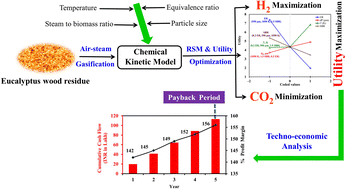H2-rich syngas production from gasification involving kinetic modeling: RSM-utility optimization and techno-economic analysis
Abstract
In this research article, H2 rich syngas production is optimized using response surface methodology (RSM) and a utility concept involving chemical kinetic modeling considering eucalyptus wood sawdust (CH1.63O1.02) as gasification feedstock. By adding water gas shift reaction, the modified kinetic model is validated with lab scale experimental data (2.56 ≤ root mean square error ≤ 3.67). Four operating parameters (i.e., particle size “dp”, temperature “T”, steam to biomass ratio “SBR”, and equivalence ratio “ER”) of air–steam gasifier at three levels are used to frame the test cases. Single objective functions like H2 maximization and CO2 minimization are considered whereas for multi-objective function a utility parameter (80% H2 : 20% CO2) is considered. The regression coefficients (RH22 = 0.89, RCO22 = 0.98 and RU2 = 0.90) obtained during the analysis of variance (ANOVA) confirm a close fitting of the quadratic model with the chemical kinetic model. ANOVA results indicate ER as the most influential parameter followed by T, SBR, and dp. RSM optimization gives H2|max = 51.75 vol%, CO2|min = 14.65 vol% and utility gives H2|opt. = 51.69 vol% (0.11%↓), CO2|opt. = 14.70 vol% (0.34%↑). The techno-economic analysis for a 200 m3 per day syngas production plant (at industrial scale) assured a payback period of 4.8 (∼5) years with a minimum profit margin of 142% when syngas selling price is set as 43 INR (0.52 USD) per kg.

- This article is part of the themed collection: Advances in Sustainable Hydrogen Energy


 Please wait while we load your content...
Please wait while we load your content...